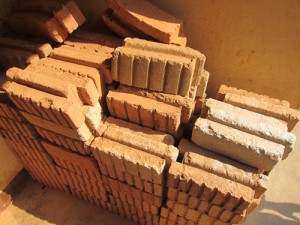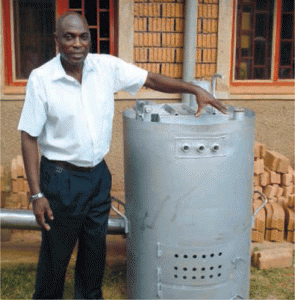Many of us dream of owning a decent home. Yet many of us continue to wonder how we can pull off that ‘miracle’. How is it possible with ever increasing costs of land and construction materials to build a house of your dreams when you have limited income? Well, the good news is yes you can own that home and more so at a cheaper cost. With less than 20 million shillings you can own a two bed room house with modest interior furnishing thanks to the new technology pioneered by Dr. Moses Kiiza Musaazi of Makerere University Faculty of Technology.
According to Musaazi, it’s possible to have a two bed room (3-4 meters master bedroom and 3-3 m) house with living room (3-4m), toilet and shower (1.5-2m) and kitchen (2-3m) at just 18 million shillings in less than three weeks. He says such a house costs the owner half the amount he/she would have spent using ordinary technology of bricks, cement and sand. How can that be possible, is the question we put to the hitherto, electrical engineer turned civil engineer.
“You see, using the ordinary technology of bricks, sand and cement is not only environmentally destructive but also very expensive and wasteful. Our tested and proven technology of making blocks (instead of bricks) using cement and soil extracted from the site of construction is both time and resource friendly,” Dr. Musaazi says.
It is blocks not bricks
Musaazi says that while in ordinary construction the site is cleared and the excavated soil ferried away, in this appropriate technology driven system, the very soil extracted to erect building foundation is a vital raw material for making the blocks used in actual construction. The blocks are commonly known as Interlocking Stablised Soil Blocks. The main features of difference between them and ordinary bricks is that blocks are bigger and interlock-fit into each other well- during construction thus enabling less usage of cement at the same time rendering laying them an easy task.
“Because the blocks are identical and interlock well, there is no need for re-modification to fit. This enables the builder to do his work quickly at the same time saving resources because there is nothing removed from the blocks,” explains Musaazi who revealed that over 1500 houses have been constructed using the blocks including his office block at Faculty of Technology, Makerere University.
He says construction using blocks also make both internal and external walls of the structure straight and uniform allowing the builder to economise cement by using same level of thickness while plastering the walls.
Easy to make
The blocks are made on site of construction using a mixture of soil, cement and water. Soil is the biggest raw material at the ratio of 95 kg to 5kg of cement. The amount of water added to complete the mix depends on the already existing water content in the soil. “One bag of cement is added to eight wheel barrows full of soil. Then sprinkle a little amount of water to make it damp. The resultant damp will give you 150 blocks,” demonstrates Musaazi who has won many awards for this innovation.
 After the mixture turns into damp it is put into the block making machine which is manually operated. The damp is compressed to reduce the damp by 40% to form into blocks. “After the blocks are removed from the machine, they are ready to use after four hours contrary to 28 days one spends waiting for the ordinary bricks to get ready,” observes Musaazi. He contends that while 30% of ordinary bricks is lost during burning, transportation and construction, the blocks are very solid and don’t break easily. He says a single block cost Ushs 180 by the time it’s ready for use.
After the mixture turns into damp it is put into the block making machine which is manually operated. The damp is compressed to reduce the damp by 40% to form into blocks. “After the blocks are removed from the machine, they are ready to use after four hours contrary to 28 days one spends waiting for the ordinary bricks to get ready,” observes Musaazi. He contends that while 30% of ordinary bricks is lost during burning, transportation and construction, the blocks are very solid and don’t break easily. He says a single block cost Ushs 180 by the time it’s ready for use.
Musaazi reveals that the blocks are also used in construction of underground and surface water tanks as well as septic tanks. To date, Musaazi has won contracts with schools, hospital and lately he is negotiating with a $7.5 million with UN-Habitat for humanity to construct over 2000 teachers’ houses and health centers’ medical staff in northern Uganda.
Environmentally friendly
The blocks do not need burning/firing or clay to be made hence avoiding tree cutting and degrading environment by emitting smoke. For this innovation and others like MakPad-an innovation that helped make very affordable sanitary pads for especially poor girls-has earned Musaazi recognition nationally and internationally.
By Enoch Mutabaazi, Ultimate Media


Pingback: In Loving Memory of our Dear Friend Enoch Mutabaazi | Uganda Multimedia News and Information